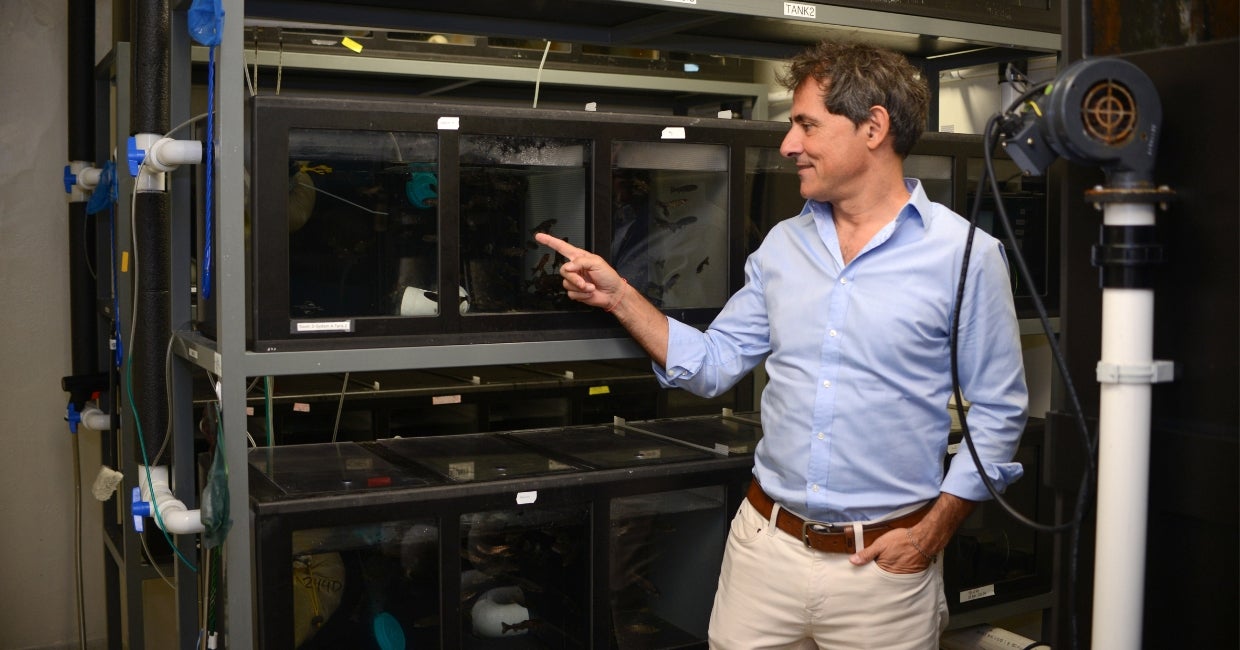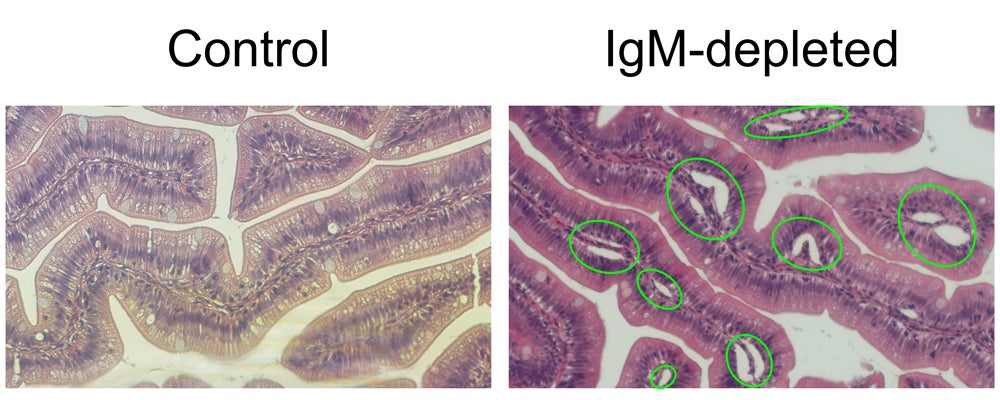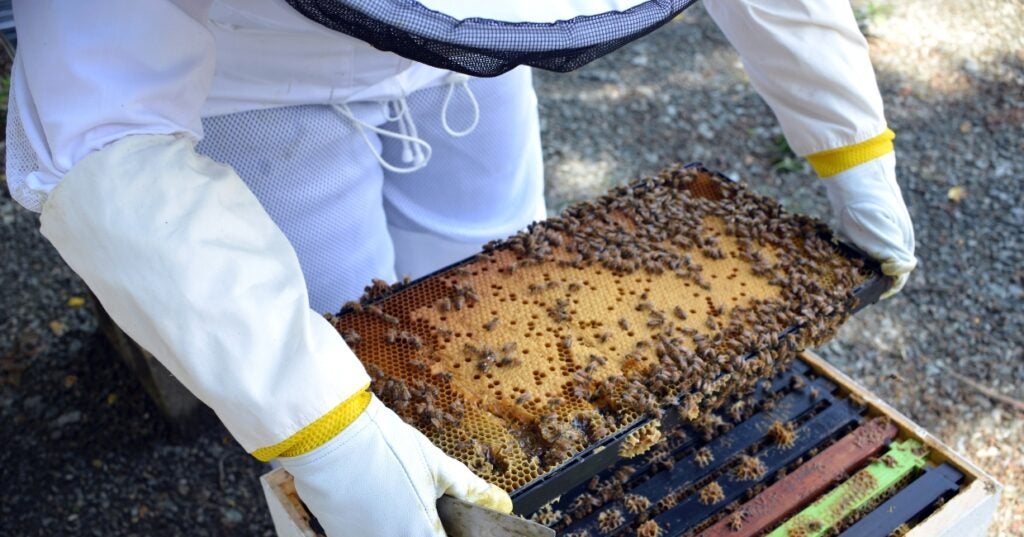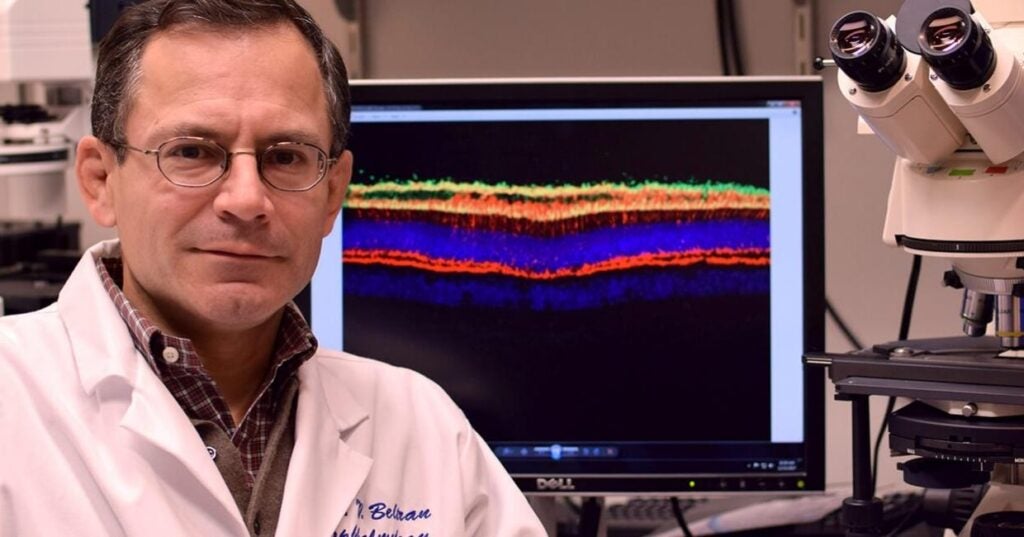A New Study from Penn Vet Reveals an Unsung Immune Defender as a Key Guardian of Gut Health and Metabolism

Faculty In This Story
Researchers uncover the critical role of secretory immunoglobulin M (sIgM) in maintaining microbiota balance, regulating metabolism, and protecting against disease
A pioneering new study published in Nature Microbiology, led by Oriol Sunyer, PhD, and a team of researchers at the University of Pennsylvania’s School of Veterinary Medicine (Penn Vet) and the University of New Mexico, have uncovered a surprising new player in gut health: an antibody called secretory immunoglobulin M (sIgM). While another antibody, secretory immunoglobulin A (slgA), has long been known for helping balance the bacteria in our intestines, this new research shows that sIgM may be just as vital—if not more so—in protecting gut health and maintaining overall well-being.
Secretory immunoglobulins—immunoglobulins found in the mucosal surfaces or linings of various organs and tracts of vertebrates—modulate the colonization, composition, and metabolism of the gut microbiome. While sIgA and secretory immunoglobulin T (sIgT) are considered the key immunoglobulins involved in the maintenance of microbiome homeostasis in the gut of mammals and fish, respectively, Sunyer and his colleagues challenged this paradigm by demonstrating that sIgM plays a crucial and non-redundant role in the regulation of gut microbiota and metabolism.
The gut microbiome contributes to essential physiological processes such as digestion and synthesis of key metabolites while also influencing immunological and neurological functions. It is well known that sIgA in mammals and sIgT in fish coat a sizable proportion of the gut microbiota. This coating is crucial for colonization of beneficial gut bacteria and modulates the composition of the gut microbiome and its metabolism. However, recent studies have shown that a considerable proportion of the fish and human microbiota are also coated by sIgM, thus suggesting a role of this immunoglobulin in the maintenance of microbiome homeostasis.
Challenging assumptions about how our bodies maintain microbial balance
To elucidate sIgM’s impact on the gut microbiome, Oriol and his team studied rainbow trout in which slgM was selectively and temporarily depleted. This teleost fish species is a unique model because its sIgM coats its gut bacteria, similar to humans. In contrast, the microbiota of laboratory mice is not coated by sIgM, thus making fish the only tractable animal model to study the role of sIgM in microbiome homeostasis.

The lack of sIgM in the fish gut induced an imbalance in the composition of its microbiome, a phenomenon known as dysbiosis, which is typically associated with intestinal diseases and dysregulation of many physiological processes. These fish also exhibited significant tissue damage (Fig. 1) and inflammation in the gut, driven by changes in the microbiome composition.
“These detrimental effects in the gut correlated with weight loss in the fish, probably due to changes in the microbiome composition and the metabolic consequences of such changes,” said Sunyer, professor of immunology and microbiology. “Also, in the absence of sIgM, gut bacteria could be observed breaching the gut cavity, or lumen, into the gut epithelium, thereby entering the circulatory system.”
sIgM identified as critical regulator of gut integrity and immune defense
The adverse effects of this lack of gut sIgM suggested a protective role of this immunoglobulin against colitis-like pathology. Fish lacking IgM suffered high mortality levels when subjected to an experimental colitis model. Interestingly, researchers found that the cause of these fish deaths was bacteria in the bloodstream and septic shock. The findings support the role of sIgM in keeping the gut bacteria within the confines of the gut lumen at the onset of colitis-like pathology.
“These results are significant,” noted Sunyer. “They point to systemic IgM’s role in targeting breached gut microbiota for destruction through activation of the complement system, phagocytosis, or other immune mechanisms, although this hypothesis requires further study.”
Since sIgA in mammals regulates bacterial metabolites, the researchers questioned whether a lack of sIgM could lead to changes in the metabolites produced by the gut microbiome. They found that microbial-derived metabolites were significantly altered in the absence of sIgM. Notably, beneficial short-chain fatty acids (SCFAs) were significantly increased. These metabolites are uniquely produced by our microbiota and are critical for gut healing and immune regulation.
“Due to the capacity of SCFAs to promote gut tissue repair, it is tempting to speculate that SCFAs were produced in response to the gut damage induced by the lack of sIgM,” commented Sunyer. “Our future studies will focus on identifying potential host signals that elicit such a response by the microbiome upon the generation of damage in the gut.”
Targeting slgM and the microbes they recognize may unlock therapies for inflammatory gut disorders
Another type of bacterially-produced metabolite that was upregulated in the gut of sIgM-depleted fish was essential amino acids, critical for tissue repair and for the synthesis of most host and microbial proteins. These outcomes suggest a previously unrecognized role for sIgM in modulating bacterial metabolism and thus entail a new capacity of this antibody class beyond its well-demonstrated role in targeting pathogens for elimination.
The discovery of sIgM’s function in regulating gut microbiota composition and metabolism reshapes our understanding of IgM’s role in immunity. The previously unrecognized capabilities of this ancient antibody class establish IgM as an essential custodian of the gut by keeping its tissue integrity through the maintenance of a healthy microbiome, which in turn supports organismal homeostasis.
“Recognizing sIgM as a master regulator of microbial communities and their metabolic outputs paves the way for exploring interventions that modulate sIgM levels or that target its functions as well as the microbes that sIgM recognizes,” explained Sunyer. “Such interventions may not only be instrumental in alleviating the symptoms of patients suffering from inflammatory gut conditions such as ulcerative colitis, inflammatory bowel diseases, and Crohn’s disease, but also from patients whose dysregulated microbiome has an impact on other physiological processes, including digestive, immunological, and neurological imbalances.”
J. Oriol Sunyer (co-corresponding author) is a professor of immunology and microbiology in the Department of Pathobiology in the School of Veterinary Medicine at the University of Pennsylvania.
Authors include Penn Vet’s Yang Ding (co-first author), Alvaro Fernández-Montero (co-first author), Ryuichiro Miyazawa, Congjin Zhou, Lise Chaumont, Stephen D. Cole, Yasuhiro Shibasaki (Nihon University), and Fumio Takizawa (Fukui Prefectural University); University of New Mexico’s Irene Salinas (co-corresponding author), Amir Mani, Marijan Posavi, and Elisa Casadei (Oklahoma State University).
The study was supported by the NIH (2R01GM085207-09); the USDA (USDA-NIFA 2021-06961 and USDA-NIFA 2022-67015); the International Postdoctoral Exchange Fellowship Program by the Office of China Postdoctoral Council (PC2018016 to Ding); and the Japan Society for the Promotion of Science (Overseas Research Fellowship, KAKENHI 20K22594 and KAKENHI 21H02288).
Related News

Researchers Advance mRNA Delivery to the Retina Using Stabilized Lipid Carriers
Efficient delivery of synthetic mRNA to the retina remains one of the key hurdles in developing mRNA-based treatments for vision loss.

A New Penn Vet Study Aims to Shed Light on Honeybees’ Foraging Habits, with an Eye Toward Aiding their Survival
A new study recently underway at the University of Pennsylvania School of Veterinary Medicine’s (Penn Vet) New Bolton Center, led by Associate Professor of Epidemiology Laurel Redding, aims to shed…

Penn Vet Researchers Evaluate a New Device That Could Streamline Vision-Saving Therapies
Retinal blindness caused by the death of photoreceptors, the light-sensing cells within the retina, affects millions of people worldwide. Novel gene and cell therapies to prevent or rescue vision loss…
About Penn Vet
Ranked among the top ten veterinary schools worldwide, the University of Pennsylvania School of Veterinary Medicine (Penn Vet) is a global leader in veterinary education, research, and clinical care. Founded in 1884, Penn Vet is the first veterinary school developed in association with a medical school. The school is a proud member of the One Health initiative, linking human, animal, and environmental health.
Penn Vet serves a diverse population of animals at its two campuses, which include extensive diagnostic and research laboratories. Ryan Hospital in Philadelphia provides care for dogs, cats, and other domestic/companion animals, handling more than 34,600 patient visits a year. New Bolton Center, Penn Vet’s large-animal hospital on nearly 700 acres in rural Kennett Square, PA, cares for horses and livestock/farm animals. The hospital handles more than 6,200 patient visits a year, while our Field Services have gone out on more than 5,500 farm service calls, treating some 18,700 patients at local farms. In addition, New Bolton Center’s campus includes a swine center, working dairy, and poultry unit that provide valuable research for the agriculture industry.

